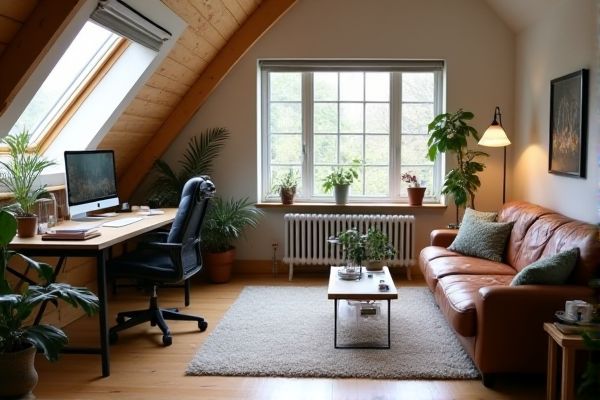
An attic workspace offers better insulation and quieter surroundings, making it ideal for focused tasks, while a garage workspace provides ample space and easier access for larger projects and tools. Discover which option suits Your needs best by exploring the full comparison in the rest of this article.
Table of Comparison
| Feature | Attic Workspace | Garage Workspace |
|---|---|---|
| Space | Limited, often angled ceilings | Spacious, open floor plan |
| Lighting | Natural light from skylights | Varies; windows or artificial light |
| Ventilation | Usually poor, needs improvement | Better airflow, can be adapted |
| Temperature Control | Prone to heat in summer, cold in winter | Easier to insulate and heat/cool |
| Noise Isolation | Good, away from main living areas | Less isolated, near garage door |
| Accessibility | Requires stairs, may limit heavy equipment | Ground-level, easy access |
| Cost | Potentially higher renovation cost | Often lower renovation and setup cost |
| Use Case | Ideal for quiet, focused work | Best for messy, noisy projects |
Overview: Attic Workspace vs Garage Workspace
Attic workspaces offer insulated, quiet environments with natural light and are ideal for focused tasks, while garage workspaces provide larger, more accessible areas suited for heavy-duty projects and storage. Attics often require proper ventilation and insulation upgrades for comfort, whereas garages benefit from easy access to tools, vehicles, and outdoor entry. Choosing between an attic or garage workspace depends on project type, space requirements, and climate control preferences.
Space and Layout Comparison
Attic workspaces often offer limited headroom and irregular shapes due to roof slopes, which can restrict furniture placement and reduce usable floor area. Garage workspaces typically provide more open, rectangular layouts with higher ceilings and easier access, accommodating larger equipment and flexible storage solutions. Maximizing functionality depends on the attic's insulation and lighting versus the garage's ventilation and electrical capacity.
Lighting and Ventilation Differences
Attic workspaces typically benefit from natural light through skylights, but may suffer from limited air circulation and potential overheating due to poor ventilation. Garage workspaces often have larger windows or doors that allow better airflow, reducing humidity and improving indoor air quality. Proper lighting and ventilation in either space are crucial to prevent fatigue and maintain comfort during extended work periods.
Insulation and Temperature Control
Attic workspaces often benefit from superior insulation due to the presence of existing roof insulation materials, which help maintain consistent temperatures and reduce heating and cooling costs. In contrast, garage workspaces typically require added insulation upgrades such as wall and ceiling panels to manage temperature fluctuations effectively. Proper insulation in both spaces enhances comfort and energy efficiency, but attics generally provide a more stable climate with less modification.
Accessibility and Convenience
An attic workspace typically requires climbing stairs and navigating narrow access points, which can limit daily accessibility and convenience. Garage workspaces offer easier accessibility with ground-level entry and ample space for moving larger tools and materials. The convenience of a garage workspace is enhanced by direct outdoor access, making it suitable for projects involving heavy equipment or frequent loading and unloading.
Noise Levels and Distractions
Attic workspaces typically offer quieter environments due to their separation from main living areas and street noise, reducing distractions and enhancing concentration. Garage workspaces, often adjacent to driveways or streets, can be noisier with frequent interruptions from vehicles and outdoor activities. Your choice depends on whether you prioritize a noise-controlled setting (attic) or convenience and accessibility (garage).
Storage Solutions and Organization
Attic workspaces often benefit from custom-built shelving and modular storage units that maximize vertical space and utilize otherwise underused areas, making them ideal for organizing tools and supplies neatly. Garage workspaces typically feature heavy-duty wall-mounted racks, pegboards, and overhead storage systems designed to handle bulkier items and provide easy access to frequently used equipment. Efficient organization in both spaces relies on tailored solutions that suit the specific dimensions and environmental conditions, optimizing accessibility and maintaining order.
Cost and Renovation Considerations
Converting an attic into a workspace typically involves substantial insulation, ventilation, and structural reinforcements, resulting in higher renovation costs compared to a garage conversion. Garage workspaces often require less extensive remodeling but may need electrical upgrades and moisture control to ensure comfort and functionality. Budget planning should account for these differences, with attic conversions generally demanding a larger investment due to complex renovations and compliance with building codes.
Safety and Security Factors
Attic workspaces offer enhanced security due to limited access points, reducing the risk of unauthorized entry compared to garages often exposed to external doors and windows. Safety in attics depends on proper ventilation and reinforced flooring to support equipment, while garages require adequate fireproofing and secure storage for hazardous materials to prevent accidents. Both spaces benefit from installing smoke detectors and secure locks, but attics typically provide a safer environment from intrusions and environmental hazards.
Best Use Cases: Attic vs Garage Workspaces
Attic workspaces excel in quiet, climate-controlled environments ideal for focused tasks such as writing, design, or remote office work, benefiting from natural light through skylights and insulation. Garage workspaces best suit projects requiring ample room and ventilation, like woodworking, automotive repairs, or storage-heavy hobbies, due to easy access and durable flooring. Both spaces offer customizable options, but attics prioritize comfort and noise reduction, while garages emphasize functionality and workspace adaptability.
 homyna.com
homyna.com